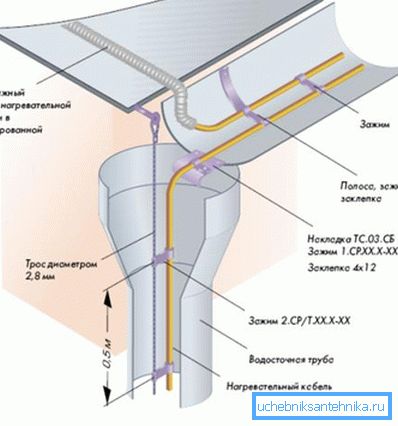Wire for heating pipes - the best means of freezing
In the greater territory of our vast country in the winter, there is an acute problem of protecting water and sewage systems from freezing. The laying of pipes below the freezing point is not always possible, plus for irregularly heated buildings, such as a dacha, it generally loses its meaning.
Heating wire for pipes, in this case will be the best solution.
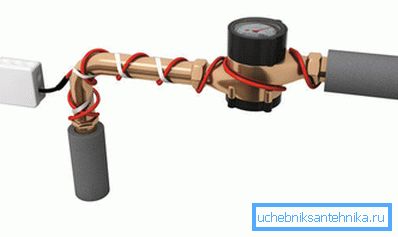
Why is it needed
First of all, let's start with the fact that this method does not replace traditional passive insulation of communications. The fact is that passive insulation does not warm the structure, it only slows down the process of lowering the temperature in the system.
By mounting the heating wire for pipes, we ensure optimal temperature conditions. The table shows the dependence of the thickness of passive insulation on the pipe section.
| Pipe section | |||||||
| In mm | 15 | 20 | 25 | 32 | 40 | 50 | 65 |
| In inches | 1/2 | 3/4 | one | 11/4 | 11/2 | 2 | 21/2 |
| The minimum thickness of the insulating layer of the pipe | |||||||
| In mm | 20 | 20 | thirty | thirty | 40 | 50 | 65 |
In addition, the system design, in addition to extended pipelines, also includes shut-off devices, these are various valves and shut-off valves, in the area of which freezing is also possible. Wire heating pipes successfully solves this problem.
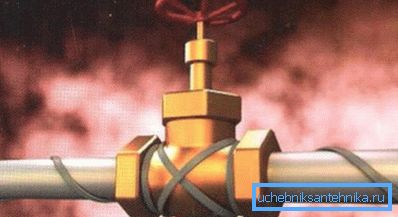
Types of heating cable
The principle of operation itself is based on the banal increase in the temperature of the conductor included in the electrical circuit. Currently, there are 2 types of specialized cables, which differ in the principle of operation and arrangement of heating elements.
Resistive cable
This type of cable products has been known for a long time. Its work is based on the inclusion in a closed circuit of a heating wire having a predetermined resistance. Both wires with one heating thread and multicore cables are produced. The instruction recommends that thermal relays be introduced into such circuits to control heating.
The weak point of these chains is that they can only be of a certain, predetermined length, when cutting the chain breaks and the system stops working. For a certain length of the line, its cross section of the core is selected; if it is cut and joined, making it shorter, the thread will heat up more and may simply burn out.
In addition, it is forbidden to cross such lines between themselves. This is the same boiler, only longer.
Self-regulating system
The work of this system is based on the use of advanced technologies. The cable consists of 2 wires, between which a conductive polymer is placed, in some sources it can be referred to as a semiconductor matrix.
When the ambient temperature decreases, the polymer begins to heat up more, and not along the entire length of the line, but only in the cold sector, for which it is also called the smart cable.

In addition, the lines of small length, which actually are holiday cottages and private houses, do not need to use additional thermostatic equipment.
Such a cable is much easier to install. Self-regulating heating wire for pipes can be cut into sectors of the desired length. Plus he is not afraid of intersections or overlays.
Important: the price of a self-regulating cable is, on average, a quarter higher than that of a resistive cable. But this gap is compensated by the fact that resistive systems require the installation of additional thermostatic equipment.
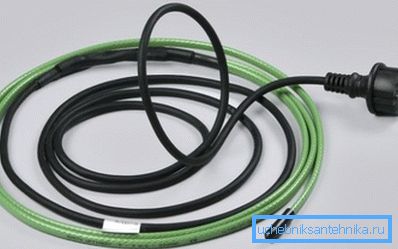
Subtleties of installation
It is possible to mount a heat wire for pipes from the outside as well as from the inside of the pipe. Each method is good in its own way, so you need to choose depending on the structure of the structure, the diameter of the pipe and the purpose of the system, sewage or water supply.

Interior layout
- The internal type of installation is more preferable for an already operating system. With this approach, you do not need to dig up the pipe to establish outdoor heating.
- In addition, heat transfer will occur directly into the cavity of the pipe excluding heat loss when the walls are heated. This method is more suitable for plumbing, in a sewer more aggressive environment, plus there is a danger of cable overgrowing.
- The positive factor here is that the internal heating wire for pipes is much easier to notice, although for its installation you will need to embed an additional gland into the system, installation through locking devices is strictly prohibited.
- For installation, you need to know exactly the length of the heated sector. Ideally, it is desirable to secure the thread on both sides. But, as a rule, it is enough to embed the line in the direction of the fluid. Such cables are easily damaged, so any wrinkles or touching sharp corners should be avoided, especially in the area of the stuffing box.
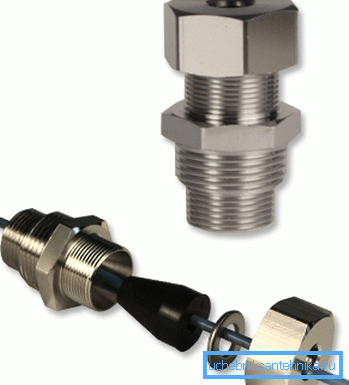
Important: in case of introduction to the plumbing system, care should be taken to ensure that this material is certified accordingly. The price of such products is higher, but their own health is more expensive.
Outdoor heating
The wire for heating pipes outside is much easier to fix, it can be done even with your own hands without having any serious professional training.
The main thing here is to exclude the possibility of mechanical damage to the line during operation.
- The cable should be fixed on the surface of the carrier with a special foil tape.. Note that the usual stationery or building tape is strictly prohibited to use. In the process of installation, do not forget that the resistive cable should not intersect.
- Can be fixed in different ways, snake, spiral, in one or more lines. It all depends on the required power and heating area. Initially, a thread with an interval of 30-50 cm is point-fixed across its strip.
Next you need to glue the entire track completely on top of the thread. To heat the sewage system it is quite enough to let one conductor along the bottom of the pipe.
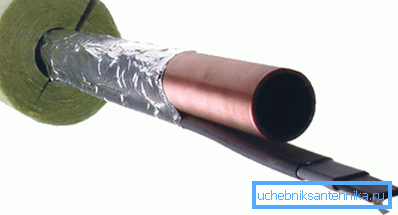
Tip: plastic pipes have a low heat capacity, so heat them harder. To increase heat transfer, it is recommended to pre-wrap the pipe with foil. Foil is a metal and when heated it will expand the area of the heated surface.
- If temperature-controlled sensors are provided in the circuit, they can be placed directly on the pipe surface, but not near the thread, but at some distance. Otherwise, the relay will constantly knock out.

Important points
- If the pipe is laid to a depth of more than 50 cm and is additionally insulated, the heating wire for pipes is recommended to be installed in those areas where the average temperature in winter falls below -15? С.
- The diameter of the bend of the cable should not be less than 6 radii of the cable.
- Any of the presented systems must be equipped with a protective device, emergency shutdown or RCD.
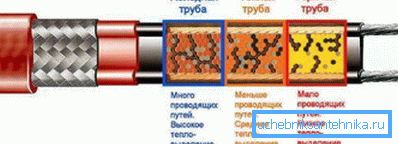
The video in this article shows the subtleties of mounting the heating cable.
Conclusion
Sewerage and plumbing is not the only area of use of this technology. Now it is widely used for heating the roof, as protection against the growth of icicles on drains and much more.
